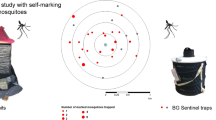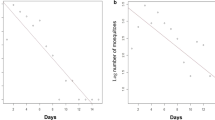Abstract
Two mark-release-recapture experiments were carried out on a female population of A. africanus in the Zika Forest, in Uganda, to estimate density, survival rates, dispersal range and duration of the gonotrophic cycle. Marking was achieved using powdered fluorescent pigments and wet paint. In the first experiment, unfed A. africanus female mosquitoes were marked and released. A high overall recapture rate of 17.6% was recorded consisting mainly of first recaptures (up to 85.6%). The highest recapture rate was recorded during the first 4 days after release. Using Jolly’s Stochastic Model, daily population estimates ranged from 1386 to 8406 during the first 7 days of release. The daily average population estimated over the first 10 days was 3591. Using the Simple Lincoln Index, population estimates ranged from 1104 mosquitoes to 16,320 with an average daily estimate of 3706. Of interest was the fact that the average daily population estimates using the two methods were not statistically significant. The 24-hr survival rate averaged over 9 days was 0.9228. Dispersal was rather random, and appeared to be of a limited range with an average distance of 50 m. In the second experiment, which involved marking only fully engorged mosquitoes, an overall recapture rate of 7.1% was recorded, with an average daily survival rate of 0.8209 averaged over the first 4 days. The pattern of recaptures indicated a gonotrophic cycle of 5–6 days with a small proportion of mosquitoes seeking secondary feeds during the first 48 hr. It was generally observed that marking and handling did not have any marked effect on mosquitoes during the first 8 days.
Similar content being viewed by others
References
Buxton A. P. (1952) Observation on the diurnal behaviour of the red tail monkey (Cercopithecus ascanius schmidti) (Matschie) in a small forest in Uganda. J. Anim. Ecol. 21, 25–58.
Conway G. R., Trpis M. and McClelland G. A. H. (1974) Population parameters of the mosquito Aedes aegypt. (L) estimated by mark-release-recapture in a suburban habitat in Tanzania. J. Anim. Ecol. 43, 289–304.
Corbet P. S. (1964) Observations on mosquitoes ovipositing in small containers in Zika Forest, Uganda. J. Anim. Ecol. 33, 141–164.
Fisher R. A. and Ford E. B. (1947) The spread of a gene in natural conditions in a colony of the moth Panaxia dominula (L). Heredity, Lond. 1, 143–174.
Gillett J. D. (1971) Mosquitoes. Weidenfeld & Nicolson, London.
Haddow A. J. (1954) Studies on the biting habits of African mosquitoes. An appraisal of methods employed, with special reference to 24-hour catch. Bull. ent. Res. 45, 199–242.
Haddow A. J. (1961) Studies on the biting habits and medical importance of East African mosquitoes in the genus Aedes. II. Subgenera Mucidus, Deceromyia, Finlaya and Stegomyia. Bull. ent. Res. 52, 317–351.
Haddow A. J. (1964) Observations on the biting habits of mosquitoes in the forest canopy at Zika, Uganda with special reference to the crepuscular periods. Bull. ent. Res. 55, 589–608.
Haddow A. J. (1968) The natural history of yellow fever in Africa. Proc. R. Soc. Edinburg. 70, 191–227.
Haddow A. J. and Ssenkubuge Y. (1965) Entomological studies from a high steel tower in Zika Forest, Uganda. Part I. The biting activity of mosquitoes and tabanids as shown by 24-hour catches. Trans. R. ent. Soc. Lond. 117, 215–243.
Jolly G. M. (1965) Explicit estimate from capture-recapture data with both death and immigration—Stochastic Model. Biometrik. 52, 225–247.
Kerr J. A. (1933) Studies on the abundance, distribution and feeding habits of some West African mosquitoes. Bull ent. Res. 24, 493–510.
McClelland G. A. H. and Conway G. R. (1971) Frequency of blood feeding in the mosquito Aedes aegypti. Nature, Lond. 232, 485–486.
Mattingly P. F. (1952) The sub-genus Stegomyia (Diptera, Culicidae) in the Ethiopian Region. Part I. Bull. Brit. Mus. (Nat. Hist.), Entomology 2.
Philip C. B. (1929) Preliminary report of further tests with yellow fever transmission by mosquitoes other than Ae. aegypti. Am. J. trop. med. 9, 267–269.
Reuben R., Yasuno M., Panicker K. A. and Labrecque G. C. (1973) The estimation of adult population of Ae. aegypti at two localities in Delhi, India. India J. comm. Dis. 5, 154–164.
Service M. N. (1976) Mosquito Ecology. Applied Science, England.
Sheppard P. M., Macdonald W. W., Tonn R. J. and Grab B. (1969) The dynamics of an adult population of Ae. aegypt. in relation to dengue haemorrhagic fever in Bangkok. J. Anim. Ecol. 38, 661–702.
Southwood T. R. (1966) Ecological Methods. Methuen, London.
Woodall J. P. (1964) The virus isolated from arthropods at the East African Virus Research Institute in 26 years ending December 1963. Proc. E. Afr. Acad. 2, 141–146.
Author information
Authors and Affiliations
Rights and permissions
About this article
Cite this article
Sempala, S.D.K. The Ecology of Aedes (Stegomyia) Africanus (Theobald) in a Tropical Forest in Uganda: Mark–Release–Recapture Studies on a Female Adult Population. Int J Trop Insect Sci 1, 211–224 (1981). https://doi.org/10.1017/S1742758400000448
Received:
Published:
Issue Date:
DOI: https://doi.org/10.1017/S1742758400000448




